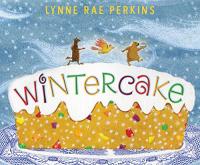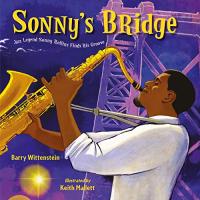
Black cat. White cat. One is stretching out, and the other is crouching. When both perch in a window, one tail is straight, the other one curly. With a mouse to entertain them, variously lost and found, they move through the day, until one cat is awake and the other asleep. The pure color and simple shapes of the stylized illustrations reveal an elegant use of negative and positive space.
Up Cat Down Cat

Two dogs on a trike turn into three dogs on a scooter until they get to 10 on yet another vehicle then back again to one. Is the tenth dog really a canine or could it be the feline who goes off on a trike? Animated illustrations and a rhyming narrative make a memorable counting adventure.
Two Dogs on a Trike

With a spin of a sturdy wheel, familiar words in different languages appear in a die-cut window atop each photograph. Babies and older people say “hello” and “goodbye” with 18 other commonplace words in-between.
20 First Words in 20 Languages

A red crab hides in order to surprise the blue fish, green sea turtle, and other colorful unsuspecting sea creatures until something bigger comes along. The rhyming text and bright illustrations are sure to inform and delight young readers.
Snap: A Happy Book of Colors

Animals can be found in forests, under the sea, and even on a safari. But in this sturdy book, one has to lift a flap — maybe two — to find them.
My Peekaboo Animals

How do you feel when you see red? Does pink make you feel differently? Explore feelings with colorful animals in rhyming text and simple illustrations, easy to find with color-coded felt tabs.
Let’s Play, Happy Giraffe! A Book of Colorful Animals

Can you find the monkey hiding in the grocery store? Join shoppers as they find and hide the small animal in this sturdy, interactive jaunt to the store.
I Thought I Saw a Monkey!

Hattie, a small rabbit, is a magician with many tricks in her hat. With an “Abracadabra, katakurico” an amazing array of animals emerge from it. Simple illustrations and repeating language make this a magical book to share.
Hat Tricks

Harris is a “very small hare with very big feet.” His grandfather helps him realize that those big, strong feet will carry Harris around the world and back. Elegant illustrations use different perspectives to show the distance the younger and older hares travel as Harris gains confidence.
Harris Finds His Feet

Lush, textured illustrations introduce animals on tall, sturdy pages. When flaps are opened, the illustrations expand and a bit of factual information is presented for a unique way to present fascinating creatures. Also by Jenkins: Sea Creatures Swim (opens in a new window).
Dinosaurs Roar

This picture book explains the concept of choosing, individually, and as a group, from making a simple choice: “Which do you like better, apples or oranges?”, to selecting a class pet, to even more complicated decisions, like electing community representatives. “If you don’t vote, you don’t get to choose.” Backmatter includes information about the United States electoral process.
I Voted: Making a Choice Makes a Difference

In this winter fable about where snow comes from, Little Snow, who wears snowflake pajamas, gets a new featherbed for the long, cold winter nights. But Mommy says this bed is for sleeping, not jumping, but when she leaves the room, he jumps and jumps on his bed … until one day it rips, sending feathers flying. A page turn reveals that his feathers are snowflakes, falling on a nghttime city block.
A Big Bed for Little Snow

A young boy wakes up in the early light of a winter morning, pulls on his boots and mittens, and steps out into the snowy city with his dad. They trudge through the snow, their dog bounding along beside them, then a slushy, steamy bus ride takes them to the tobogganing hill for some winter fun. The boy describes all the sights and sounds of the day, from the frost in Dad’s beard and the snow “pillows” in the park, to the noisy clunking snow plows and the singing buskers they pass on their way home. That night, the boy lies awake under cozy covers, reflecting on the day, as snow blankets the world outside his window.
My Winter City

Suddenly “awake” in the middle of winter, a “big bear” explores a “cozy cabin,” which Bear of course “enters excitedly.” But the cabin isn’t empty — a little girl lives there. So begins an unlikely friendship and an unexpected adventure as the girl attempts to figure out what a bear is supposed to be doing in the winter. (Hint: It’s not eating pancakes or visiting the library!)
Bear Is Awake! An Alphabet Story

When Thomas misplaces the basket of dried fruit he needs to make his seasonal wintercake, friends old and new come together to save the day. This holiday tale is full of surprises and gentle humor, and a book about holiday traditions and why they matter. It’s also a story about making mistakes and how mistakes can sometimes lead to wonderful things!
Wintercake

Look! A line of paw prints in the snow. Follow the tracks to see the rare and majestic snow leopard and visit her secret world. Join a zoologist in the Himalayan mountains as he searches for the elusive creature. With her pale gold and silver-gray coat painted with black rosettes, she blends so well into the boulders, it’s no wonder she’s thought of as a ghost of the mountains. Written by a zoologist and interwoven with fascinating facts, this look at a fascinating animal includes an end note suggesting resources to explore.
Snow Leopard: Ghost of the Mountains

In the midst of a whirling snowfall, a girl and her father pile into their big red snow plow. Through slippery streets, up winding hills, they race — clearing the snow and heading for the train station to meet a very special traveler. The rhyming text is just right for one or two readers.
Snowy Race

Alone in the snowy woods with his dog, a boy discovers the wonder of winter trees, one at a time, in a big, quiet space. On every double-page spread, four lines of simple verse and bright linoleum block prints decorated with watercolor and collage capture the stark outlines and the details of what he sees, hears, and touches (“Crunch! Our footsteps make the only sound”). The botanical facts are part of the wonder (“Trees that once had leaves are bare”). (Booklist)
Winter Trees

This celebration of winter solstice blends imagery from the long-ago revelries of northern Europeans with modern-day observations and global traditions. As the sun set on the shortest day of the year, early people would gather to prepare for the long night ahead. They built fires and lit candles and played music, bringing their own light to the darkness. This is a tale of hope, anticipation, love, and joy.
The Shortest Day

Louisa May Alcott is best known for penning Little Women, but few are aware of the experience that influenced her writing most — her time as a nurse during the Civil War. Caring for soldiers’ wounds and writing letters home for them inspired a new realism in her work, including Little Women, which was one of the first novels to be set during the Civil War.
Louisa May’s Battle: How the Civil War Led to Little Women

The life of Marguerite Johnson, better known as Maya Angelou, vividly comes to life in free verse and swirling images. Young Maya found solace in language, the rhythm of words during her difficult childhood in “the seesaw of the South,” and fast-paced St. Louis. She became a performer, a poet, and a highly respected novelist. A forward by her grandson encourages discussion as the book is shared. Photographs accompany a timeline of Maya’s life which concludes this sophisticated book.
Rise! From Caged Bird to Poetry of the People, Maya Angelou

He was born in the jazz age so it’s not surprising that Walter Theodore “Sonny” Rollins loved jazz. He loved the saxophone and was a talented musician who became widely recognized. Free verse effectively explores Sonny’s life — including the hiatus he took from public performances, instead playing for himself on the Williamsburg Bridge. Jazzy illustrations enliven the handsome presentation.
Sonny’s Bridge: Jazz Legend Sonny Rollins Finds His Groove

Luminous illustrations and free verse combine to tell the story of Martin Luther King, Jr.’s “I Have a Dream” speech. When King arrived for the March on Washington in 1963, his speech was not yet completed. Nonetheless, he found a “place to land” to complete his historical speech then give it on the steps of the Lincoln Memorial. Focusing on this singular moment in history is powerful and stunningly presented in word and image.
A Place to Land: Martin Luther King Jr. and the Speech That Inspired a Nation

How do we know something that is invisible is really all around? With our noses! Human “noses can detect more than 400,000 different smells.” Animals use their noses for different reasons; dogs smell marked territory, great white sharks detect prey. Sometimes humorous illustrations and flaps that lift reveal a bundle of information sure to inspire further inquiry.
